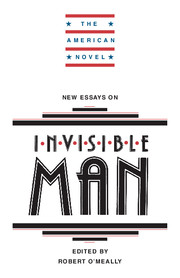Book contents
- Frontmatter
- Contents
- Series Editor's Preface
- 1 Introduction
- 2 The Meaning of Narration in Invisible Man
- 3 Frequencies of Eloquence: The Performance and Composition of Invisible Man
- 4 Ralph Waldo Ellison: Anthropology, Modernism, and Jazz
- 5 Ellison's Masks and the Novel of Reality
- 6 The Conscious Hero and the Rites of Man: Ellison's War
- Notes on Contributors
- Selected Bibliography
3 - Frequencies of Eloquence: The Performance and Composition of Invisible Man
Published online by Cambridge University Press: 05 June 2012
- Frontmatter
- Contents
- Series Editor's Preface
- 1 Introduction
- 2 The Meaning of Narration in Invisible Man
- 3 Frequencies of Eloquence: The Performance and Composition of Invisible Man
- 4 Ralph Waldo Ellison: Anthropology, Modernism, and Jazz
- 5 Ellison's Masks and the Novel of Reality
- 6 The Conscious Hero and the Rites of Man: Ellison's War
- Notes on Contributors
- Selected Bibliography
Summary
In Ralph Ellison's Invisible Man, the narrator is a failed orator. Because he is unable to communicate directly with those he meets in American society, Invisible Man abandons the oral tradition in favor of a “compulsion to put invisibility down in black and white” (439). Yet Invisible Man moves back and forth over frequencies of both the spoken and the written word. After giving up as a speechmaker, he writes an improvisatory, vernacular narrative of utterance. But the Prologue and Epilogue with which he frames his tale reveal a continuing, obsessive pursuit of an audience. In the Prologue he is too hurt and vulnerable to risk intimate address even to readers he cannot see. So he puts on a defiant, sometimes hostile mask of invisibility impenetrable to readers except on his terms. Then, as he writes down his story, he does the tough rhetorical psychological work of creating a resilient, genuine voice. After he has told his story, he feels liberated enough to write an Epilogue. There he converses with readers in an intimate, ironic voice whose democratic eloquence calls us to respond with our own dangerous, courageous, socially responsible verbal acts.
Three decades after the publication of Invisible Man, Ellison explores the fluctuating, often ambiguous, sometimes contentious relation between the novel and the oral tradition.
Information
- Type
- Chapter
- Information
- New Essays on Invisible Man , pp. 55 - 94Publisher: Cambridge University PressPrint publication year: 1988
Accessibility standard: Unknown
Why this information is here
This section outlines the accessibility features of this content - including support for screen readers, full keyboard navigation and high-contrast display options. This may not be relevant for you.Accessibility Information
- 10
- Cited by
